 Triumph Street Scrambler - Owner's Manual > How to Ride the Motorcycle
Triumph Street Scrambler - Owner's Manual > How to Ride the Motorcycle
How to Ride the Motorcycle

- STOP position
- RUN position
- START position
- Ignition switch
- ON position
- Neutral indicator light (Street Twin and Street Scrambler only)
- Neutral indicator light (all other models)
To Stop the Engine
Caution
The engine should normally be stopped by turning the ignition switch to the OFF position. The engine stop switch is for emergency use only. Do not leave the ignition switched on with the engine stopped. Electrical damage may result.
Close the throttle completely.
Select neutral.
Turn the ignition switch off.
Select first gear.
Position the motorcycle on a firm, level surface with the side stand
Lock the steering
To Start the Engine
Warning
Never start the engine or run the engine in a confined area. Exhaust fumes are poisonous and can cause loss of consciousness and death within a short period of time. Always operate your motorcycle in the open air or in an area with adequate ventilation.
Caution
Do not operate the starter continuously for more than five seconds as the starter motor will overheat and the battery will become discharged. Wait 15 seconds between each operation of the starter to allow for cooling and recovery of battery power.
Do not let the engine idle for long periods as this may lead to overheating which will cause damage to the engine.
The low oil pressure warning light should go out shortly after the engine starts.
If the low oil pressure warning light stays on after starting the engine, stop the engine immediately and investigate the cause. Running the engine with low oil pressure will cause severe engine damage.
Check that the engine stop switch is in the RUN position.
Make sure the transmission is in neutral.
Turn the ignition switch on.
Note:
When the ignition is switched on, the instrument warning lights will illuminate and will then go off
Pull the clutch lever fully into the handlebar.
Leaving the throttle fully closed, push the starter button until the engine starts.
The motorcycle is equipped with starter lockout switches. The switches prevent the electric starter from operating when the transmission is not in neutral with the side stand down.
If the side stand is extended whilst the engine is running, and the transmission is not in neutral then the engine will stop regardless of the clutch lever position.
Moving Off
Pull in the clutch lever and select first gear. Open the throttle a little and let out the clutch lever slowly. As the clutch starts to engage, open the throttle a little more, allowing enough engine speed to avoid stalling.
Changing Gears
Warning
Take care to avoid opening the throttle too far or too fast in any of the lower gears as this can lead to the front wheel lifting from the ground (pulling a 'wheelie') and to the rear tyre breaking traction (wheel spin).
Always open the throttle cautiously, particularly if you are unfamiliar with the motorcycle, as a 'wheelie' or loss of traction will cause loss of motorcycle control and an accident.
Warning
Do not change to a lower gear at speeds that will cause excessive engine rpm (r/min). This can lock the rear wheel causing loss of control and an accident. Engine damage may also be caused. Changing down should be done such that low engine speeds will be ensured.

- Gear change pedal (6 speed shown)
Close the throttle while pulling in the clutch lever. Change into the next higher or lower gear. Open the throttle part way, while releasing the clutch lever. Always use the clutch when changing gear.
Note:
The gear change mechanism is the 'positive stop' type. This means that, for each movement of the gear change pedal/lever, you can only select each gear, one after the other, in ascending or descending order.
Braking

- Front brake lever

- Rear brake pedal
Warning
WHEN BRAKING, OBSERVE THE FOLLOWING: Close the throttle completely, leaving the clutch engaged to allow the engine to help slow down the motorcycle.
Change down one gear at a time such that the transmission is in first gear when the motorcycle comes to a complete stop.
When stopping, always apply both brakes at the same time. Normally the front brake should be applied a little more than the rear.
Change down or fully disengage the clutch as necessary to keep the engine from stalling.
Never lock the brakes, as this may cause loss of control of the motorcycle and an accident.
Warning
For emergency braking, disregard down changing, and concentrate on applying the front and rear brakes as hard as possible without skidding.
Riders should practice emergency braking in a traffic-free area.
Triumph strongly recommends that all riders take a course of instruction, which includes advice on safe brake operation. Incorrect brake technique could result in loss of control and an accident.
Warning
For your safety, always exercise extreme caution when braking (whether or not ABS is fitted), accelerating or turning as any incautious action can cause loss of control and an accident. Independent use of the front or rear brakes reduces overall braking performance. Extreme braking may cause either wheel to lock, reducing control of the motorcycle and causing an accident (see ABS warnings below).
When possible, reduce speed or brake before entering a turn as closing the throttle or braking in mid-turn may cause wheel slip leading to loss of control and an accident.
When riding in wet or rainy conditions, or on loose surfaces, the ability to manoeuvre and stop will be reduced.
All of your actions should be smooth under these conditions. Sudden acceleration, braking or turning may cause loss of control and an accident.
Warning
When descending a long, steep gradient or mountain pass, make use of the engine's braking effect by down changing and use both front and rear brakes intermittently. Continuous brake application or use of the rear brake only can overheat the brakes and reduce their effectiveness leading to loss of motorcycle control and an accident.
Warning
Riding with your foot on the brake pedal or your hands on the brake lever may actuate the brake light, giving a false indication to other road users. It may also overheat the brake, reducing braking effectiveness leading to loss of motorcycle control and an accident.
Warning
Do not coast with the engine switched off, and do not tow the motorcycle. The transmission is pressure lubricated only when the engine is running.
Inadequate lubrication may cause damage or seizure of the transmission, which can lead to sudden loss of motorcycle control and an accident.
ABS (Anti-Lock Brake System)
Warning
Where fitted, ABS prevents the wheels from locking, therefore maximising the effectiveness of the braking system in emergencies and when riding on slippery surfaces. The potentially shorter braking distances ABS allows under certain conditions are not a substitute for good riding practice.
Always ride within the legal speed limit.
Never ride without due care and attention and always reduce speed in consideration of weather, road and traffic conditions.
Take care when cornering. If the brakes are applied in a corner, ABS will not be able to counteract the weight and momentum of the motorcycle. This can result in loss of control and an accident.
Under some circumstances it is possible that a motorcycle equipped with ABS may require a longer stopping distance than an equivalent motorcycle without ABS.
ABS Warning Light
 The ABS indicator light
illuminates to show that the ABS
function is not available. Illumination is
normal after engine start-up, and until
the motorcycle first reaches a speed
exceeding 6 mph (10 km/h). Unless there
is a fault, it should not illuminate again
until the engine is restarted.
The ABS indicator light
illuminates to show that the ABS
function is not available. Illumination is
normal after engine start-up, and until
the motorcycle first reaches a speed
exceeding 6 mph (10 km/h). Unless there
is a fault, it should not illuminate again
until the engine is restarted.
If the indicator light becomes illuminated at any other time while riding, it indicates that the ABS has a malfunction that requires investigation.
- Normally, the rider will perceive ABS operation as a harder feel or a pulsation of the brake lever and pedal. As the ABS is not an integrated braking system and it does not control both the front and rear brake at the same time, this pulsation may be felt in the lever, the pedal or both.
- The ABS may be activated by sudden upward or downward changes in the road surface.
Warning
If the ABS is not functioning, the brake system will continue to function as a non-ABS braking system. Do not continue to ride for longer than is necessary with the indicator light illuminated. Contact an authorised Triumph dealer as soon as possible to have the fault checked and rectified. In this situation, braking too hard will cause the wheels to lock resulting in loss of control and an accident.
Warning
The ABS warning light will illuminate when the rear wheel is driven at high speed for more than 30 seconds when the motorcycle is on a stand. This reaction is normal.
When the ignition is switched off and the motorcycle is re-started, the warning light will illuminate until the motorcycle reaches a speed exceeding 19 mph (30 km/h).
Warning
The ABS computer operates by comparing the relative speed of the front and rear wheels. Use of nonrecommended tyres can affect wheel speed and cause the ABS function not to operate, potentially leading to loss of control and an accident in conditions where the ABS would normally function.
Parking
Warning
Do not park on a soft or on a steeply inclined surface. Parking under these conditions may cause the motorcycle to fall over causing damage to property and personal injury.
Warning
Petrol is extremely flammable and can be explosive under certain conditions.
If parking inside a garage or other structure, be sure it is well ventilated and the motorcycle is not close to any source of flame or sparks. This includes any appliance with a pilot light.
Failure to follow the above advice may cause a fire resulting in damage to property or personal injury.
Warning
The engine and exhaust system will be hot after riding. DO NOT park where pedestrians and children are likely to touch the motorcycle.
Touching any part of the engine or exhaust system when hot may cause unprotected skin to become burnt.

Select neutral and turn the ignition switch to the OFF position.
Lock the steering to help prevent theft.
Always park on a firm, level surface to prevent the motorcycle from falling.
When parking on a hill, always park facing uphill to prevent the motorcycle from rolling off the stand. Engage first gear to prevent the motorcycle from moving.
On a lateral (sideways) incline, always park such that the incline naturally pushes the motorcycle towards the sidestand.
Do not park on a lateral (sideways) incline of greater than 6º and never park facing downhill.
Note:
When parking near traffic at night, or when parking in a location where parking lights are required by law, leave the tail, licence plate and position lights on by turning the ignition switch to P (PARK).
Do not leave the switch in the P position for long periods of time as this will discharge the battery.
Make sure that the side stand is fully retracted before riding off.
Considerations for High Speed Operation
Warning
This Triumph motorcycle should be operated within the legal speed limits for the particular road travelled.
Operating a motorcycle at high speeds can be potentially dangerous since the time available to react to given traffic situations is greatly reduced as road speed increases.
Always reduce speed in consideration of weather and traffic conditions.
Warning
Only operate this Triumph motorcycle at high speed in closed-course on-road competition or on closed-course racetracks. High speed operation should only then be attempted by riders who have been instructed in the techniques necessary for high speed riding and are familiar with the motorcycle's characteristics in all conditions.
High speed operation in any other circumstances is dangerous and will lead to loss of motorcycle control and an accident.
Warning
The handling characteristics of a motorcycle at high speed may vary from those you are familiar with at legal road speeds. Do not attempt high speed operation unless you have received sufficient training and have the required skills as a serious accident may result from incorrect operation.
Warning
The items listed below are extremely important and must never be neglected. A problem, which may not be noticed at normal operating speeds, may be greatly exaggerated at high speeds.
General
Make sure that the motorcycle has been maintained according to the scheduled maintenance chart.
Steering
Check that the handlebar turns smoothly without excessive free play or tight spots. Make sure that the control cables do not restrict the steering in any way.
Luggage
Make sure that any luggage containers are closed, locked and securely fitted to the motorcycle.
Brakes
Check that the front and rear brakes are functioning correctly.
Tyres
High speed operation is hard on tyres, and tyres that are in good condition are crucial to riding safely. Examine their overall condition, inflate to the correct pressure (when the tyres are cold), and check the wheel balance. Securely fit the valve caps after checking tyre pressures. Observe the information given in the maintenance and specification sections on tyre checking and tyre safety.
Fuel
Have sufficient fuel for the increased fuel consumption that will result from high speed operation.
Caution
In many countries, the exhaust system for this model is fitted with a catalytic converter to help reduce exhaust emission levels.
The catalytic converter can be permanently damaged if the motorcycle is allowed to run out of fuel or if the fuel level is allowed to get very low.
Always make sure you have adequate fuel for your journey.
Engine Oil
Check that the engine oil level is correct.
Make sure that the correct grade and type of oil is used when topping up.
Drive Chain
Make sure that the drive chain is correctly adjusted and lubricated.
Inspect the chain for wear and damage.
Coolant
Check that the coolant level is at the upper level line in the expansion tank.
Always check the level with the engine cold.
Electrical Equipment
Make sure that all electrical equipment such as the headlight, rear/brake light, direction indicators and horn all work correctly.
Miscellaneous
Visually check that all fixings are tight.
See also:
 Triumph Street Scrambler - Owner's Manual > Ignition Switch/Steering Lock
Triumph Street Scrambler - Owner's Manual > Ignition Switch/Steering Lock
Warning For reasons of security and safety, always turn the ignition to the OFF or PARK position and remove the key when leaving the motorcycle unattended.
 Triumph Street Scrambler - Owner's Manual > Accessories, Passengers and Loading
Triumph Street Scrambler - Owner's Manual > Accessories, Passengers and Loading
Accessories and Loading The addition of accessories and carriage of additional weight can affect the motorcycle's handling characteristics causing changes in stability and necessitating a reduction in speed. The following information has been prepared as a guide to the potential hazards of adding accessories to a motorcycle and carrying passengers and additional loads.
 Ducati Scrambler
Ducati Scrambler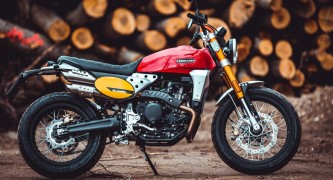 Fantic Caballero 500
Fantic Caballero 500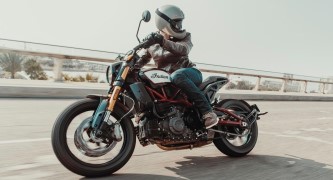 Indian FTR 1200
Indian FTR 1200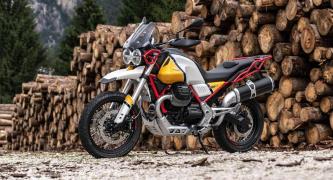 Moto Guzzi V85 TT
Moto Guzzi V85 TT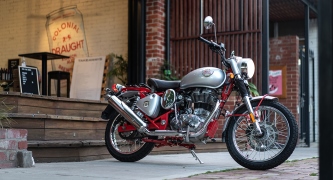 Royal Enfield Bullet Trials Works Replica
Royal Enfield Bullet Trials Works Replica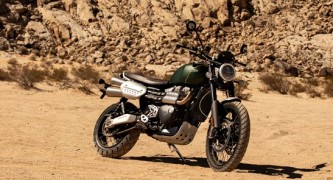 Triumph Scrambler 1200 XE
Triumph Scrambler 1200 XE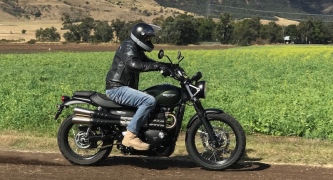 Triumph Street Scrambler
Triumph Street Scrambler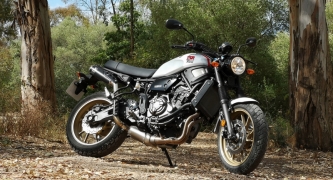 Yamaha XSR700
Yamaha XSR700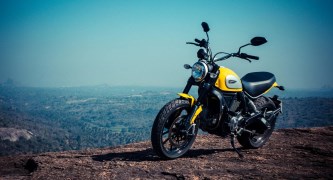 Ducati Scrambler 800
Ducati Scrambler 800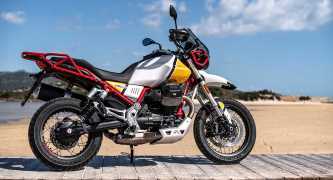 Moto Guzzi V85 TT
Moto Guzzi V85 TT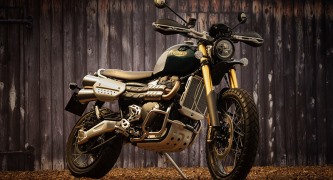 Triumph Scrambler 1200 XC
Triumph Scrambler 1200 XC